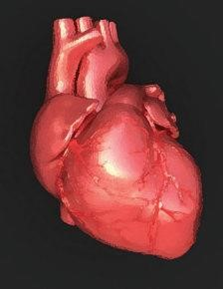Lesson Notes By Weeks and Term - Primary 6
THE HUMAN BODY (BLOOD CIRCULATION)
WEEK 10
SUBJECT: BASIC SCIENCE AND TECHNOLOGY
TERM: 1ST TERM
CLASS: PRIMARY 6
TOPIC: THE HUMAN BODY (BLOOD CIRCULATION)
BEHAVIOURAL OBJECTIVES: AT THE END OF THE LESSON, PUPILS SHOULD BE ABLE TO:
INSTRUCTIONAL MATERIALS:
A chart showing the human heart
REFERENCE MATERIALS
Scheme of work
All relevant materials
9-Years Basic Education Curriculum
Online information
BUILDING BACKGROUND/CONNECTION TO PRIOR KNOWLEDGE:
Pupils are familiar with the topic in their previous classes.
CONTENT OF THE LESSON
The heart is the muscular organ that pumps blood round the body. It contains four chambers namely:
(Hi) Right ventricle
(iv) Left ventricle
The major difference between the auricles and the ventricles is that the walls of the ventricles are thicker and more muscular than those of the auricles.

Functions of the Heart
The functions of the heart include the following:
(j) The major function of the heart is to pump blood to all parts of the body.
(ii) It also keeps blood in continuous flow round the body.
Blood Vessels
Blood vessels are tubes through which blood moves round the body. These vessels are; arteries, veins, and capillaries and they have various functions in the body. Arteries carry blood away from the heart, while veins carry blood towards the heart.
Capillaries join arteries to the veins.
Blood Circulation
The circulatory system is the route by which blood moves round the body. It is made up of the heart blood, and blood Vessels.
Functions of the blood circulatory system
The blood circulatory system in the human body has several functions. They are as follows:
When disease-causing organisms enter the human body, the white blood cells attack and swallow them, or produce chemicals called antibodies that kill the disease-causing organisms.
By clotting at the point of an injury, the blood protects the body against further loss of blood.
Some parts of the body, e.g. the muscles produce more heat than others. The blood circulatory system distributes heat evenly throughout the body. There are two types of blood circulation in the body. These are: Pulmonary circulation and Systemic circulation.
The right auricle and ventricle contains blood with less oxygen and more scarbon dioxide. The left auricle and ventricle contains blood with more oxygen that comes from the lungs.
The heart is filled with blood, as a result of the relaxation of the involuntary muscles of the heart called cardiac muscle. When the muscles of the heart contract, it (the heart) pumps blood out through the right and left ventricles into the pulmonary arteries and aorta respectively.
The blood in the pulmonary arteries goes to the lungs and the blood in the aorta goes to other parts of the body.
The presence of valves prevent the blood from flowing back to the heart.: When the heart is relaxed, blood returns to the heart from the veins through vena-cava to the right auricles and through the pulmonary veins to the left auricles. The blood that moves into the body cells is more oxygenated because the blood flows by the indication of the arrows.
Functions of the arteries and veins
The arteries carry blood away from the heart and the veins carry blood towards the heart.
Functions of the capillary blood vessels
If blood were to flow all the time within the blood vessels, it would not be of much use to the body. The capillaries have thin walls through which the liquid part of the blood can diffuse out of the blood vessels to reach the living cells in the various organs. In this way, the capillaries make it possible for the cells of the body to be supplied with food, water, oxygen and all other essentials. They are also useful in the removal of waste products from the cells
Differences between Arteries Veins 1. They carry blood away from the heart. They carry blood towards the heart. 2. They have thick elastic walls. They have thin, not very elastic walls. 3. They carry blood that contain oxygen (except the pulmonary artery) They carry blood in which oxygen has been used up (except the pulmonary vein) 4. Pressure of blood in the vessels is high Pressure of blood in the vessels is low. 5.They do not have valves. They have valves to prevent the back-flow of blood. 6. Arteries are located deeper in the surface of the body than veins. Veins are located nearer the flesh than arteries. 7. Pulse is detectable. Pulse is usually not detectable. Assessment & Evaluation: (WRAP-UP CONCLUSION) Teacher goes over the topic once again to enhance better understanding Answer these questionsborder="1">
Lesson Notes All Rights Reserved 2023